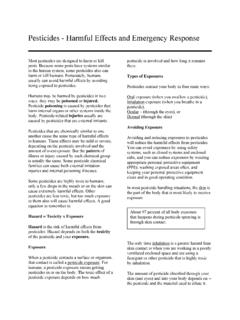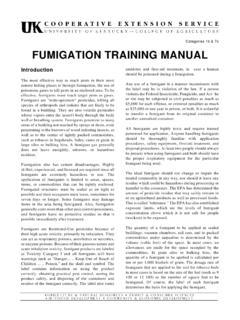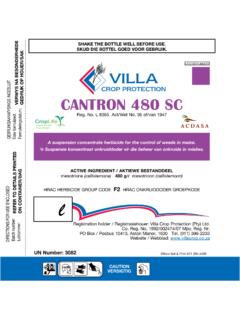Transcription of INSECTICIDE RECOMMENDATIONS FOR GRAIN …
1 INSECTICIDE RECOMMENDATIONS FOR GRAIN sorghum (MILO) 2018 ENT 24 Prepared by Raul Villanueva, Extension Entomologist Producing sorghum (milo) for GRAIN is important in many Kentucky farm management systems. GRAIN sorghum is subject to infestation by a variety of insect pests. However, following a few good production practices can greatly reduce insect pest infestations. To establish need and estimate proper timing for GRAIN sorghum insect control, fields should be sampled at least weekly from emergence to maturity. Plant at the proper time, usually as soon as possible after the soil temperature reaches 65o 70o F. (See AGR 18 GRAIN & Forage Crop Guide for Kentucky). Planting too early may result in infestation by greenbugs and chinch bugs, while late planting will increase problems with sorghum midge, fall armyworm, and sorghum webworm. Do not plant in fields infested with Johnsongrass. Do not make sequential plantings strive for even bloom in fields.
2 Know the difference between pest and beneficial insects. Check with your County Extension Agent for Agriculture about training in pest identification, damage thresholds and control measures (Integrated Pest Management and Pesticide Safety Education). Additional Information IPM 5, Kentucky IPM Manual for GRAIN sorghum provides information about identification, life cycle, scouting techniques, and threshold values for the common pests. It is available at: Fact sheets on specific pests are posted at: This publication and other educational materials are also available to the producer through your County Extension Office. Using Insecticides Properly Products listed in this publication are not the only products labeled for use. These products are commonly used and generally available in Kentucky. You may find many other products with different trade names containing the same active ingredient. Be sure the product you choose is labeled for the intended use and is registered in Kentucky.
3 This publication is an abbreviated guide; it is not a substitute for a product label. Before using any pesticide, read the entire label. Note the sections containing directions for use, restrictions, and the warning and precautionary statements. The user takes full responsibility for any deviation from label directions. The user should be thoroughly familiar with the proper safety equipment required ( goggles, protection suits, respirators, etc.) to afford maximum protection. It is a good idea for all persons to know exactly what is being applied and at what rate. Chemicals listed in bold italics are Restricted Use pesticides. Persons buying, using, or supervising the use of these pesticides must be certified as competent to do so. Certification training is available from your county extension agent for agriculture. Check for information on certification. INSECTICIDE Use for Plant Health Response It is my position that insecticides should only be used to reduce, prevent, avoid, or mitigate insect pests or problems related to insect activity (such as the vectoring of certain diseases).
4 I do not encourage nor recommend the use of insecticides for plant health responses in the absence of arthropod pest management. I feel that insecticides should be used to protect the yield and quality of agricultural products. In my opinion, using insecticides for reasons other than pest management unnecessarily increases the potential for non target impacts, development of INSECTICIDE resistance, and exposure of mixers and applicators. Multiple Active Ingredient Insecticides There are a number of products on the market which contain multiple INSECTICIDE active ingredients (AIs). Examples are: Cobalt (chlorpyrifos and gamma cyhalothrin), Besiege (lambda cyhalothrin and chlorantraniliprole), Brigadier (bifenthrin and imidacloprid), Hero (zeta cypermethrin and bifenthrin), Endigo (lambda cyhalothrin and thiamethoxam), Leverage (imidacloprid and cyfluthrin), Swagger (bifenthrin and imidacloprid), Voliam Xpress (lambda cyhalothrin and chlorantraniliprole), and Voliam Flexi (thiamethoxam and chlorantraniliprole).
5 These products are not recommended for use when products containing a single INSECTICIDE AI, provides comparable control unless there is a specific need to use multiple AIs for resistance management of specific, difficult to manage pests. The use of multiple INSECTICIDE AIs when a single AI will 2suffice may expose sub economic pest populations to selection pressure and increases the likelihood of non target effects on pollinators and natural enemies of arthropod pests. Selecting Which INSECTICIDE to Use Using the same INSECTICIDE over and over is never a good idea. This may lead to resistance within the targeted pest population. The tables below are set up to allow you to different among products, while products may have different trade names the may have the same active ingredient or a different active ingredient but the same mode of action. Note that the Trade name (above) and active ingredient name (below are listed in the left most column.)
6 In addition the second column will list the active ingredient s Mode of Action (MOA). The mode of action is an indication of how the INSECTICIDE kills the pest. Choosing products with different modes of action will aid in avoiding resistance. Preplant Soil Treatments for Greenbugs Greenbugs are rarely reported as pests in Kentucky, and if present, are usually the result of planting too early. Preventive treatments are not recommended unless recurrent problems develop. If a problem is anticipated the granular soil applied INSECTICIDE , Counter, and the seed applied INSECTICIDE Cruiser, Poncho and Concur are labeled for at planting use. Aphids are almost never a problem on Kentucky grown sorghum (But see Sugarcane Aphid !). Corn leaf aphids are commonly found but do no damage; greenbugs, are rarely important on emerging plants during drought, and yellow sugarcane aphids though present have been of little importance to date.
7 See IPM 5 (listed above) for description and treatment thresholds. Foliar treatments Foliar Treatments for Greenbugs INSECTICIDE MOA Rate per Acre Days to Harvest or Forage Dimethoate 4 E (dimethoate) 1B 1/2 to 1 pt. 28 ( GRAIN , feed, graze) Lorsban 4E (chlorpyrifos) 1B 2 pt. 30 ( <1pt.) or 60 (1 2 pt.) GRAIN , forage, fodder, hay, silage Treat plants from emergence to 6 when there is visual damage on all plants. Foliar Treatments for sorghum Midge INSECTICIDE MOA Rate per Acre Days to Harvest/Forage Asana XL (esfenvalerate) 3A to fl. oz. 21 Baythroid XL (cyfluthrin) 3A 1 to fl. oz. 14 Dimethoate 4E (dimethoate) 1B 1/4 to 1/2 pt. 28 ( GRAIN , feed graze) Lannate SP (methomyl) 1A 1/4 to 1/2 lb. 14 GRAIN , grazing or feeding Lorsban 4E (chlorpyrifos) 1B 1/2 pt. 30 GRAIN , forage, fodder, hay, silage Mustang Max (zeta cypermethrin) 3A to 4 fl. oz. 14 ( GRAIN & stover)45 (forage) Warrior II (lambda cyhalothrin) 3A to fl.
8 Oz. 30 ( GRAIN )Do not graze or harvest for feed 3 Begin scouting for midge as the panicles emerge from the boot. Control will be necessary if there is more than one per head during bloom. Johnson grass, late planting, continuous cropping and large numbers of rogues contribute to increasing sorghum midge numbers. Foliar Treatments for Corn Earworm, sorghum Webworm, Fall Armyworms INSECTICIDE MOA Rate per Acre Days to Harvest/Forage Baythroid XL (cyfluthrin) 3A to fl. (Bacillus thuringiensis) 11A Aid in control of caterpillars can be obtained using many products containing . Some examples are Javelin, Dipel and Lepinox. Check labels for details. Days to Harvest = 0. Belt SC ( read note below) (flubendiamide) 28 2 to 4 fl. oz. 14 ( GRAIN / stover, 3 forage Sevin 4F (carbaryl) 1A 1 to 2 qt. 21( GRAIN & fodder)14 (Forage & Silage) Lannate SP (methomyl) 1A to 1/2 lb. 14 GRAIN , grazing or feeding Lorsban 4E (chlorpyrifos) 1B 1 pt.)
9 (Webworm)2 pt. (CEW) 30(1pt.) 60(>pt.) GRAIN , forage, fodder, hay, silage Mustang Max (zeta cypermethrin) 3A to 4 fl. oz. 14 ( GRAIN & stover) 45 (forage) Tracer (spinosad) 5 to 3 fl. oz. 7( GRAIN or fodder) 14(forage or hay) Warrior II (lambda cyhalothrin) 3A to fl. oz. 30 ( GRAIN ) Do not graze or harvest for feed As EPA has issued a notice to cancel all flubendiamide registrations in 2016, growers can still use existing stocks following directions specified on its label until December 31, 2019. Foliar Treatments for Grasshoppers (See: Three Common Kentucky Grasshoppers and their Natural Enemies. Entfact 116. INSECTICIDE MOA Rate per Acre Days to Harvest/Forage Baythroid XL (cyfluthrin) 3A 2 to fl. oz. 14 Sevin 4F (carbaryl) 1A to qt. 21( GRAIN & Fodder)14 (Forage & Silage) Dimethoate 4 (dimethoate) 1B 1 pt. 28 ( GRAIN , feed, graze) Lorsban 4E (chlorpyrifos) 1B to 1 pt. 30 GRAIN , forage, fodder, hay, silage Mustang Max (zeta cypermethrin) 3A to 4 fl.)
10 Oz. 14 ( GRAIN & stover) 45 (forage) Warrior II (lambda cyhalothrin) 3A to fl. oz. 30 ( GRAIN ) Do not graze or harvest for feed These insects are primarily head feeders, though some foliage feeding may occur. Treatment is warranted if populations reach 3 small sorghum webworm or 1 corn earworm or fall armyworm per head; Or if 50% of the plants are infested with fall armyworm feeding in the whorl pre bloom. Lorsban is not labeled for fall armyworm control. 4 Sugarcane Aphid Sugarcane aphid is a new and potentially very important pest of milo in Kentucky. First noticed as a major pest in the south in 2014 and first recorded in the commonwealth during the 2015 GRAIN production season, this pest has shown the ability to reach the Purchase, Pennyrile, Green River and Mammoth Cave regions of Kentucky. At present this is believed to be an annual migrant overwintering in southern Texas. There is much to be learned about this pest; it is certainly important in the Mississippi River valley the southeast, and from central Texas through central Kansas.


